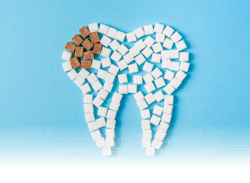Caries risk management in practice
V. Kim Kutsch, DMD
Each day I go to my office and try to do something to show that I treat people better—better than the guy down the road and better than I treated people yesterday or last year. In all my years of trying daily to treat people better, I believe that improving caries risk management is one of the best ways to do this. I have been implementing and tweaking my protocol for over a decade. If you have dabbled in caries risk management but don’t yet have a standard protocol, or if you’ve never tried implementing a caries risk management philosophy but want to, then this article is for you.
Caries risk management is a standard of care that has three defining characteristics:
• Early risk assessment
• Diagnosis of the caries disease process
• Treatment with minimally invasive procedures
Let’s first consider early risk assessment. While it may be easy to identify patients with obvious caries lesions, this is not the real intent of early risk assessment. The real intent is to discover why patients have cavities. What risk factors are contributing to their disease states? What factors can be modified? Modifiable risk factors include behaviors such as diet, snacking frequency, and home care. Nonmodifiable risk factors include things such as prescription medication use and other health concerns (diabetes, asthma, special needs, etc.). A caries risk management protocol should offer information to guide a preventive treatment protocol based on patients’ statistical risks of developing decay in the future.
It is best to start with a standardized caries risk assessment (CRA) form for all patients in the practice to gather baseline data. Several standardized CRA forms are available. The Journal of the California Dental Association’s form has been clinically validated by John Featherstone, PhD, of the University of California, San Francisco.1 I have modified this form and developed a simpler, but equally effective (in my experience) tool.2 The CRA form should act as a support and diagnostic tool for the team. If it is overly complicated, then enthusiasm for the program tends to decline quickly. If, however, the CRA form acts as a valuable communication tool between patient and practitioner, a caries risk management program can be a vibrant and central part of the dental practice.
Use of a biometric tool to screen the patients’ biofilm has helped me measure progress and provide a surrogate endpoint to therapy for patients whose biofilm activity is contributing to their decay risk. One option is an adenosine triphosphate (ATP) bioluminescence test, which is a rapid, simple, and accurate chairside biometric test that involves a swab and a meter.
Once risk factors have been identified, then practitioners can hone their counseling skills on managing behaviors while also providing therapeutic strategies (products) to overcome risk factors that are unmodifiable. Think of it as creating a balance between risk factors and protective factors that reestablishes a healthy biofilm and a healthy mouth. Treatment recommendations should be as individualized to a patients’ specific risk factors as possible. If a patient has a bacterial issue, an antibacterial should be part of the protocol. If a patient’s risk involves severe dry mouth, a dry-mouth product should be included, and so forth.
The best immediate anticaries therapy is the use of fluoride varnish.3 At-risk patients should receive an immediate fluoride varnish and again every three months on a regular basis until they are healthy. Fluoride varnish provides the best fluoride substantivity and requires the least patient participation.4,5
There are billable codes related to caries risk assessment (including but not limited to the following):
• D0601: caries risk assessment and documentation with a finding of low risk using recognized assessment tools
• D0602: caries risk assessment and documentation with a finding of moderate risk using recognized assessment tools
• D0603: caries risk assessment and documentation with a finding of high risk using recognized assessment tools
Caries risk management has been a successful addition to my practice. It has not only helped with my diagnosis and treatment of patients, but bettered my relationships with them. If you want to reach for better things for your patients and practice, caries risk management may be a good fit for your practice too.
References
1. Domejean-Orliaquet S, Gansky SA, Featherstone JD. Caries risk assessment in an educational environment. J Dent Educ. 2006;70(12):1346-1354.
2. Caries Risk Assessment Forms and Product Guides. CariFree website. https://carifree.com/resources/new-cra-forms-and-product-guides/.
3. Azarpazhooh A, Main PA. Fluoride varnish in the prevention of dental caries in children and adolescents: a systematic review. J Can Dent Assoc. 2008;74(1):73-79.
4. American Dental Association Council on Scientific Affairs. Professionally applied topical fluoride: evidence-based clinical recommendations. J Dent Educ. 2007;71(3):393-402.
5. Quock RL, Warren-Morris DP. Fluoride varnish: the top choice for professionally applied fluoride. Tex Dent J. 2010;127(8):749-759.
V. KIM KUTSCH, DMD, graduated from the University of Oregon School of Dentistry in 1979. He is an inventor, product consultant, and speaker. He is a past president of the Academy of Laser Dentistry and the World Congress of Minimally Invasive Dentistry and a reviewer for several journals, including The Journal of the American Dental Association. Dr. Kutsch serves as CEO of Oral BioTech and maintains a private practice in Albany, Oregon.
